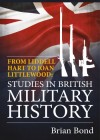Book Review - From Liddell Hart to Joan Littlewood
Studies in British Military History
By Brian Bond
Helion, Solihull, 2015, 978-1-9107-7757-2, 238pp.
Reviewed by Brigadier Chris Roberts AM, CSC (Retd)
Covering a diverse range of subjects, this splendid book presents a selection of Professor Brian Bond’s insightful and thought provoking essays from a long academic career in war studies. Highly readable, the essays represent scholarship of the highest order that command respect and consideration irrespective of one’s views on each of the topics addressed. Bond began his academic career in the late 1950s, at a time when the ‘Lions led by Donkeys’ shibboleth gained momentum, and he retired in 2001 after the mythology grounded in that perception had been repudiated by sound academic research. Bond, a highly respected and prolific author, contributed to that change, being among those who challenged the prevailing public view. These essays represent some his finest work. Presented in four parts they cover the Great War, the inter-war years, the Second World War, and, somewhat incongruously in terms of the subjects presented, post 1945.
Leading off in ‘Part I The First World War’, Bond questions certain historical and public interpretations of that conflict in three essays: tackling the main controversies surrounding Britain’s role in the war, and how they have evolved over time; a penetrating analysis of Sir Basil Liddell-Hart’s polemic, anti-high command approach and his influence on other historians; and a discussion of how the 1916 Battle of the Somme has been presented by historians over the succeeding century. Each essay provides food for thought on how history can be perverted to suit an author’s political leanings or support a particular cause. A fourth essay considers the deteriorating and acrimonious relations between the British Government, particularly the Prime Minister, David Lloyd George, and the British High Command during the difficult year of 1917.
In ‘Part II The Inter War Decades’, Bond addresses three subjects. First, he contests the view, portrayed in subsequent literature and critiques, that many of the veterans who published their memoirs, and the famous war poets, were anti-war. Bond then analyses the British Army’s approach to modernisation in the 1920s and 1930s, and why it was so ill-prepared for war in 1939. In this he places much of the blame on a parsimonious Government that was reluctant to accept a Continental commitment, starving the Army of the funds necessary for modernisation and preparedness. Lastly, he considers the performance of the reforming Minister for War, Leslie Hore-Belisha. Bond considers how Hore-Belisha strove to belatedly modernise the Army immediately prior to the outbreak of the Second World War, and how the Army’s High Command (and in particular General Lord Gort - Chief of the Imperial General Staff (CIGS) from 1937-39) misinterpreted his efforts. Both this chapter, and that relating to Lloyd George and the High Command in 1917, provide a sad but telling indictment on the consequences of disharmony between a government and its military leaders.
Moving onto ‘Part III The Second World War’, Bond presents five fine essays: two addressing the British Army in France in 1939-40, and three assessing senior military leadership. The first relates the varied experiences of British soldiers during the chaotic campaign in May 1940, considering their discipline, when confusion reigned supreme during the retreat, and then within the Dunkirk perimeter during the evacuation. It also touches on two massacres of prisoners of war by the Waffen SS. The second essay is a case study of the Arras counter-attack against Rommel’s 7th Panzer Division on 21st May, and the lessons to be derived from the action. Both essays are instructive on the implications of ill-prepared and inadequate forces, disorganised command and control, and faulty planning. In terms of leadership in high command, the essay on Generals Edmund Ironside (CIGS in1939-40) and Lord Gort (Commander-in Chief of the British Expeditionary Force over the same period), stands in stark contrast to that on General William Slim (General Officer Commanding of the 14th Army in Burma). Both ought to be read by those aspiring to high command. Indeed, the essay on Slim is an exemplar that many in leadership and management positions would benefit from reading. The third essay challenges the claim by Sir Arthur Bryant, who edited Field Marshall Lord Alanbrook’s (CIGS from 1941-1945) war diaries, that Alanbrook pursued a consistent Mediterranean strategy. While Bond presents a well-argued case, his line of reasoning is less compelling than in his other essays, in that, on occasions, he employs excerpts from Alanbrook’s diary entries that appear to be taken out of context or don’t recognise the external circumstances surrounding them. Nonetheless, it provides food for thought as a counter balance against Bryant’s adulating assertions.
Rounding out this collection of engaging and perceptive essays, in ‘Part IV After 1945’ Bond turns back to the Great War in the penultimate chapter. Here he considers, through the medium of the late 1960s film Oh! What a Lovely War, how bias and a deliberate distortion of the facts can influence the public’s understanding of war with politically motivated anti-establishment and anti-war messaging. Finally, in ‘A Farewell to Arms’ the reader gains a brief insight into Bond’s academic career and retirement. Although out of tune with the other chapters, it does provide some background to the man many readers would not know, giving a strong sense of credibility to his work.
Bond presents his cases in an engaging and highly readable style, and while one clearly senses his position on each subject, he is fair and even-handed in his discussion, demonstrating a perceptive and keen mind. In those essays relating to the mythology of the Great War, Bond shows consideration and an understanding of why others adopted a position contrary to his own. In the other essays, although he may be critical of certain people and events, he seeks to understand them and presents a balanced account and considered opinion. Overall, this is a thoroughly enjoyable and persuasive book that is not only instructive on a range of topics, but which also showcases a fine and highly respected historian at his best.
The views expressed in this article and subsequent comments are those of the author(s) and do not necessarily reflect the official policy or position of the Australian Army, the Department of Defence or the Australian Government.
Using the Contribute page you can either submit an article in response to this or register/login to make comments.



